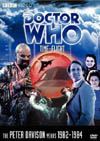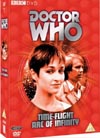DVD Extras include:
Opening ExcellenceThis story has the best first episode of the season. Mystery, exploration, a problem-solving Doctor, and good introduction for the regulars and the TARDIS. A lot of characters are thrown at us in the first 25-minutes, but since their functions are all easily understandable in human terms and foremost in their appearances, one is able to take them in easily.I suspect much of Time-Flight's bad rap comes from those fans who simply want a scary monster to hide behind the sofa from. Sorry, Time-Flight will ask the viewer to be a bit more sophisticated and follow some slightly more complex concepts while keeping up a decent pace. It targets a smarter demographic, and I think it's all the more commendable for it. Peter Davison's Doctor also shows his vulnerable side, in particular his obvious concern that the authorities might not believe his fantastic theories. One can easily imagine Tom Baker or Jon Pertwee's Doctors being loud and proud at such a moment, not caring what anybody else thought. Both approaches have their merit; you can decide for yourself which one you prefer. Davison's sensitivity will no doubt benefit him even more in other situations. And the Doctor need not worry that he'll get caught in the red tape story beat of convincing local authorities that he's on their side, as happened in so many of Malcolm Hulke's scripts, with the airport setting of "The Faceless Ones" (story no. 35) making it the most obvious comparison. This is neatly and logically side-stepped, much to the improvement of the story. Just when you thought time-space warps à la the Bermuda Triangle might rule this tale, mental powers begin to become a central challenge. The pre-historic landscape they find themselves in works for me. It is particularly atmospheric in the first episode, as it throws many images and ideas at the audience: the mausoleum, with Kalid inside directing events at some sort of altar, mysterious remnants of a space pod, and of course plasmatons. What the heck are plasmatons, and how much should we fear them and what they can do? Tune in next week to find out. Lots of wonderful elements to tantalize the viewer. All excellent. Excessive intercutting begins during this stage, but it is far more tolerable here now that we know the characters, than the quick cuts attempted in "The Claws of Axos" (story no. 57) during character introductions. As Time-Flight continues, however, it becomes less and less polished, as though Peter Grimwade's work directing "Kinda" (story no. 119) and "Earthshock" (story no. 122) prevented him from giving his script for Time-Flight another draft, which it could have benefitted so well from.
Alien MausoleumThere is a lot of interesting set design in this story. The exterior landscape is surprisingly effective for a set, and suitably alien to boot; it would have been great for an alien planet. There are also a number of fascinating interiors for the mausoleum, with Kalid's chamber being perhaps the most successful, and the corridors and the sanctum interior being fascinating as well. The larger room outside the sanctum is just as interesting to look at, but doesn't completely fit the story very well. Darker lighting might have been one minor improvement, bringing it more in line with the corridors and Kalid's chamber, not to mention making the plasmatons look more menacing. The real problem is the ridiculously thin walls separating the interior and exterior of the sanctum. It never does look like anything that would cause the amount of hard labour and headache that the script requires it to.
"I am Kalid!"Episode Two escalates really well, particularly when Peter Davison gets to confront the mysterious magician villain in his lair, and discover the methods and limits of his powers while aiding his friends in their psychic battles against Kalid's pawns. And just when you think all that might be building to a predictable cliffhanger, revelations continue and an even better one is delivered. One of the most memorable and enjoyable surprises ever from my earliest remembrances of watching the show.Of course, now we come to the spoilers, which I will save for the In-Depth Analysis version of this review, along with half of my points about plot and character motivation. If you've already seen the story, or you simply do dare, go ahead. Read it. Make my day.
Character SuccessIn the end, I think a large part of Time-Flight's success is the fact that all the characters are so easily likeable, and that they immerse themselves in futuristic ideas, settings, and challenges which most often arrive with interesting bits of video trickery. Richard Easton's charismatic Captain Stapley leads a jovial crew, aiding the Doctor on his explorations, investigations, and rescue attempts. Leon Ny Taiy is even more fun and exquisitely enjoyable to watch as Kalid. Nicely done. Give the man his round of applause! More than most other offerings this season, this story becomes the one with the characters you want to watch, doing the things that define this show within the science fiction genre. All this helps enormously when, later on, the plot becomes far less tight and satisfying than it deserved to be.Professor Hayter and Angela Clifford are important characters in giving us perspective on some of the answers to the mysteries at hand, and Hayter in particular is a welcome addition to the cast of characters. At times one questions the value of all the technobabble thrown about in this story, both for discussions and debunking of the psychic challenges, and the nuts and bolts of maintaining and flying a Concorde jet. Sometimes it seems that better scenes could have been constructed dealing with the character interactions in the plot and their ramifications. The strong sense of mystery in the story comes to a climax at the end of Part Three, when the whole backstory comes out - a very enjoyable wallowing in extra-terrestrial culture. Very nice.
Roger RandomTime-Flight is the second instalment in the run of Roger Limb's four least successful Doctor Who incidental music scores, and thankfully is the most pleasant of the bunch. I was pleasantly surprised to find a number of attempts at light-hearted melodies and more than a few half-decent cues. There is even a four-note motif running through the whole score for those keen enough to listen for it.The chief failing of this score is the apparent aimless randomness of what is being played. Limb basically chose his radiophonic synthesizer instruments three stories ago, and he appears to be just playing a lot of random notes on them a lot of the time. It fits in well enough with each scene, so nothing is ruined - far from it. But the repetitiveness of it becomes a bit much - the four note motif and the semitone drops really saying nothing musically. The Doctor discovering Kalid is perhaps the best use of this style, and my favourite cue of the story, while the melancholy melody and organ-grinder baseline backing Tegan's wistful tour of the airport becomes another highlight. Some of the deeper synth notes add dramatic undercurrent to the story here and there, and the exotic gongs during Kalid's entrance are a nice touch. Not bad. As I say, the most pleasant of Limb's bottom four.
End TransitionMost disappointing is the near complete disappearance of any thematic or truly dramatic challenges in Part Four. Transportation becomes the main focus, as Time-Flight becomes a dazzling display of how a TARDIS can come and go, finely demonstrating cross-dissolves and sound effects, interior/exterior relationships, what chameleon circuits can do (rather pointlessly), etc. Not to be outdone, the Concorde aircraft also flexes its wings and gets in on some of the act. All wonderful stuff in itself, but it is all a bit transitional, while the conflict with lead villain is reduced to barely tangible ideas of outsmarting each other in the dialogue, and some other critical conflicts get barely a passing mention.Part Four can't help but be disappointing in this respect. Giving the Doctor more to do, tangibly, on-screen, is perhaps the biggest hole. In fact, expanding this tale into a six-part story, with the last two episodes taking place on a planet that only gets mentioned often in the script, could have given the narrative room to finish dealing with all that it had stirred up, and been sweet icing on the cake. Ah well, at least the story has inspired the dream of such things. Time-Flight largely gets away with having such a transitional final episode because it is directed and imbued with such a high-spirited emotional energy, delivering a double-helping of something that the previous story could not aim to do. This helps make it ideal to follow Earthshock and close off the season. Nice work from director Ron Jones indeed.
Season 19 Rankings:
This story has become available on DVD and VHS video. Single Story versions:
Comments on this article are welcome. You may contact the author from this page:
|








